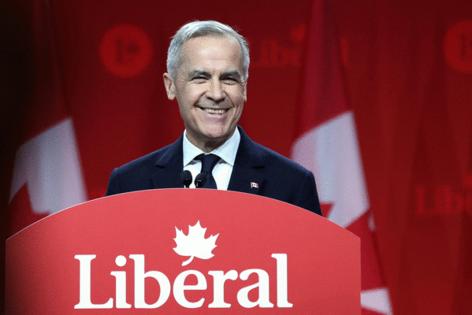Carney proposes deeper deficits to fund infrastructure, tax cut
Published in News & Features
Canadian Prime Minister Mark Carney is promising to run deeper deficits to cut income taxes and grow spending on infrastructure to reduce the country’s dependence on the U.S.
Carney’s plan would push the federal government’s shortfall to C$62.3 billion ($45 billion) this fiscal year and add C$129.2 billion in net new spending over the next four years if his Liberal Party wins the election, according to the party’s election platform, released Saturday in Ottawa.
Canada’s net deficit as a percentage of gross domestic product is expected to be 1.96% in the fiscal year that started this month, up from the 1.3% projected in December by the Liberals under former Prime Minister Justin Trudeau. The shortfall as a percentage of GDP is expected to fall to 1.35% by 2028.
“It’s said there are no atheists in foxholes. There should be no libertarians in a crisis,” Carney said at a news conference in Whitby, Ontario.
The largest spending promises include an income tax cut, defense spending, housing investments and a trade diversification fund to increase Canada’s ability to export to markets other than the U.S. The plan estimates C$20 billion in revenues from Canada’s retaliatory tariffs this fiscal year, which the Liberals say they would redistribute entirely to workers and businesses affected by the U.S. trade war.
Overall, the platform shows Canada’s fiscal position worsening if the Liberals are reelected on April 28, and the party is currently leading in most polls. Canada is unlikely to improve its debt-to-GDP ratio over the forecast horizon, which was previously a key fiscal guidepost offered by the Liberals under Trudeau.
Conservative Leader Pierre Poilievre has yet to release his party’s costed platform, but his campaign promises total in the tens of billions of dollars, including major tax cuts. He has pledged a fiscal rule that would see a dollar of savings for every dollar of new spending.
Carney’s push to spend more deeply comes as other Western nations, including Germany, also unleash deficit spending to respond to U.S. President Donald Trump’s withdrawal from traditional economic and security relationships. Canada has one of the better fiscal positions among Group of Seven countries.
Carney plans to split the budget into capital and operating expenditures, as is done in other jurisdictions including Canada’s second-largest province of Quebec.
His team says it plans to balance the operating budget by the fiscal year that starts in 2028, including through a comprehensive program review and by increasing productivity via technology such as artificial intelligence. Earlier this week, he promised to reduce the annual growth in the operating budget to 2% from about 9% currently.
“Our plan gets government spending under control, because the government has been spending too much and Canada has been investing too little,” Carney said.
The costed platform incorporates March estimates from the Parliamentary Budget Office, including a real GDP growth assumption of 1.7% in 2025. That’s higher than the 1.5% estimated in a Bloomberg survey of economists later last month.
The platform also mentions a potential issuance of Canada’s “first-ever transition bonds” of C$10 billion per year by 2027, intended to help agricultural and industrial sectors become cleaner and more competitive.
———
(With assistance from Mario Baker Ramirez.)
©2025 Bloomberg L.P. Visit bloomberg.com. Distributed by Tribune Content Agency, LLC.







Comments